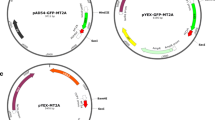Abstract
The merC gene from the Tn21-encoded mer operon has potential uses as a molecular tool for bioremediation. It was overexpressed as the fusion proteins MerC-Sso1p or MerC-Vam3p in Saccharomyces cerevisiae. Green fluorescent protein (GFP)-MerC-Sso1p fusion proteins located primarily in the plasma membrane, although some protein was detected in the endoplasmic reticulum. In contrast, GFP-MerC-Vam3p was expressed in the vacuolar membranes. These results suggest that yeast Sso1p and Vam3p are essential for targeting molecules to the plasma and vacuolar membranes, respectively. Significantly more cadmium ions were accumulated by yeast cells expressing MerC-Sso1p than with MerC-Vam3p or control cells. These results suggest that expression of MerC in the plasma membrane may be a particularly promising strategy for improving accumulation of cadmium in yeast.




Similar content being viewed by others
References
Aalto MK, Ronne H, Keränen S (1993) Yeast syntaxins Sso1p and Sso2p belong to a family of related membrane proteins that function in vesicular transport. EMBO J 12:4095–4104
Amberg D, Burke D, Strathern J (2005) Methods in yeast genetics: a Cold Spring Harbor laboratory course manual, vol 2005 edition. Cold Spring Harbor Laboratory Press, New York
Clemens S, Antosiewicz DM, Ward JM, Schachtman DP, Schroeder JI (1998) The plant cDNA LCT1 mediates the uptake of calcium and cadmium in yeast. Proc Natl Acad Sci USA 95:12043–12048
Gietz D, St Jean A, Woods RA, Schiestl RH (1992) Improved method for high efficiency transformation of intact yeast cells. Nucleic Acids Res 20:1425
Malik A (2004) Metal bioremediation through growing cells. Environ Int 30:261–278
Nagata T, Nakamura A, Akizawa T, Pan-Hou H (2009) Genetic engineering of transgenic tobacco for enhanced uptake and bioaccumulation of mercury. Biol Pharm Bull 32:1491–1495
Ostrowicz CW, Meiringer CT, Ungermann C (2008) Yeast vacuole fusion: a model system for eukaryotic endomembrane dynamics. Autophagy 4:5–19
Pan-Hou H, Kiyono M, Kawase T, Omura T, Endo G (2001) Evaluation of ppk-specified polyphosphate as a mercury remedial tool. Biol Pharm Bull 24:1423–1426
Pan-Hou H, Kiyono M, Omura H, Omura T, Endo G (2002) Polyphosphate produced in recombinant Escherichia coli confers mercury resistance. FEMS Microbiol Lett 207:159–164
Rodriguez-Navarro A, Ramos J (1984) Dual system for potassium transport in Saccharomyces cerevisiae. J Bacteriol 159:940–945
Salt DE, Wagner GJ (1993) Cadmium transport across tonoplast of vesicles from oat roots. Evidence for a Cd2+/H+ antiport activity. J Biol Chem 268:12297–12302
Sasaki Y, Minakawa T, Miyazaki A, Silver S, Kusano T (2005) Functional dissection of a mercuric ion transporter, MerC, from Acidithiobacillus ferrooxidans. Biosci Biotechnol Biochem 69:1394–1402
Shaul O, Hilgemann DW, de-Almeida-Engler J, Montagu MV, Inz D, Galili G (1999) Cloning and characterization of a novel Mg2+/H+ exchanger. EMBO J 18:3973–3980
Song WY, Sohn EJ, Martinoia E, Lee YJ, Yang YY, Jasinski M, Forestier C, Hwang I, Lee Y (2003) Engineering tolerance and accumulation of lead and cadmium in transgenic plants. Nat Biotechnol 21:914–919
Tanaka K, Nakafuku M, Tamanoi F, Kaziro Y, Matsumoto K, Toh-e A (1990) IRA2, a second gene of Saccharomyces cerevisiae that encodes a protein with a domain homologous to mammalian ras GTPase-activating protein. Mol Cell Biol 10:4303–4313
Uemura T, Ueda T, Ohniwa RL, Nakano A, Takeyasu K, Sato MH (2004) Systematic analysis of SNARE molecules in Arabidopsis: dissection of the post-Golgi network in plant cells. Cell Struct Funct 29:49–65
Wada Y, Nakamura N, Ohsumi Y, Hirata A (1997) Vam3p, a new member of syntaxin related protein, is required for vacuolar assembly in the yeast Saccharomyces cerevisiae. J Cell Sci 110:1299–1306
Acknowledgments
We are grateful to the late Dr. M. Ikeda for her valuable advice and for the gift of the yeast expression vector pKT10. We thank Mr. Y. Mochizuki for his technical assistance. We also thank Dr. D. Thiele for the YCF-1 null yeast line. This work was supported in part by a Grant-in-Aid for Scientific Research (C) (No. 21510088) to M. K. from the Ministry of Education, Science and Culture, Japan. This work was also supported in part by a Kitasato University Research Grant for Young Researchers to M. K.
Author information
Authors and Affiliations
Corresponding author
Rights and permissions
About this article
Cite this article
Kiyono, M., Miyahara, K., Sone, Y. et al. Engineering expression of the heavy metal transporter MerC in Saccharomyces cerevisiae for increased cadmium accumulation. Appl Microbiol Biotechnol 86, 753–759 (2010). https://doi.org/10.1007/s00253-009-2402-0
Received:
Revised:
Accepted:
Published:
Issue Date:
DOI: https://doi.org/10.1007/s00253-009-2402-0




